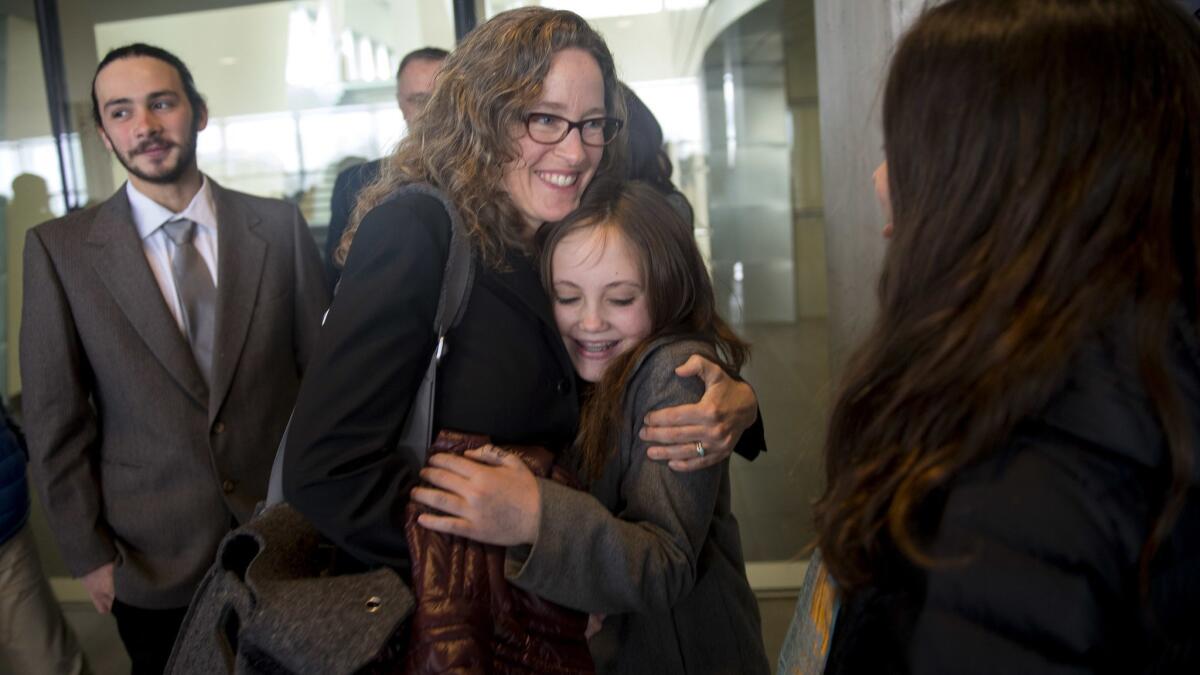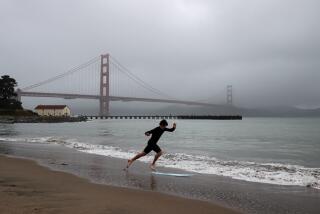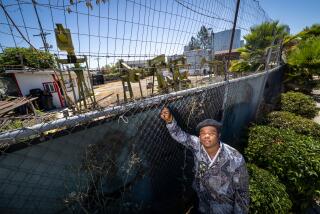Is it our constitutional right to live in a world safe from climate change?
Growing up in Fairbanks, Alaska, Nathan Baring has seen the signs of a warming world all around him. The winters have begun to lose their infamous chill. Thawing permafrost is shifting the ground beneath his feet. And some years, there isn’t even enough snow to ski.
“If you have eyes and you walk out your back door, you can see the changes that have taken place over only my short childhood,” said Baring, 19, who already has six years of climate activism under his belt.
So when lawyers asked Baring if he’d like to sue the federal government for failing to tackle climate change, he readily agreed.
“When I started, I didn’t have the right to vote,” Baring said. “This legal avenue was what I saw as the most effective way to put myself out here.”
The case, Juliana vs. United States, alleges that the U.S. government has violated the rights of 21 young Americans by permitting — and in many cases, subsidizing — the continued use of fossil fuels that cause climate change.
Juliana is the first lawsuit to argue that there’s a constitutional right to a safe and livable climate. Experts say it’s an ambitious and unprecedented tactic, and many were surprised that the case has made it this far.
“It’s a novel legal claim,” said Ann Carlson, a professor of environmental law at UCLA.
The suit has seen its share of twists and turns since it was filed in 2015. It survived numerous attempts by the Obama and Trump administrations to have it thrown out, although the courts removed the president from the list of defendants in 2018. The case still targets a slew of executive branch organizations such as the Environmental Protection Agency, the Department of Energy and the Office of Science and Technology Policy.
A trial was originally slated to begin in federal district court in February 2018 but was postponed until the fall. Then the government made an eleventh-hour plea to the U.S. Supreme Court, asking the justices to dismiss the case. They declined, but encouraged the 9th Circuit Court of Appeals to consider the government’s objections.
“The Trump administration has pulled out all the stops, legally, in trying to prevent the trial,” said Michael Gerrard, the director of the Sabin Center for Climate Change Law at Columbia University who is not involved in the suit.
Now its fate lies with three judges in Portland, Ore., who will decide if the case has enough legal merit to proceed to trial. On Tuesday, lawyers for Baring and the other young plaintiffs will try to convince them that it does. (The hourlong hearing will be livestreamed on YouTube starting at 2 p.m. Pacific time.)
For starters, they will have to refute the government’s argument that the plaintiffs don’t have standing to sue. To do that, they must show that the plaintiffs have been harmed by the government’s actions (or in this case, its inaction), and that the court can do something to remedy the problem.
The plaintiffs have a long list of injuries.
When a massive storm dumped heavy rains on southern Louisiana in 2016, Jayden Foytlin’s house flooded with storm water and sewage. For months afterward, she and her family slept in the living room of their damaged home because the bedrooms weren’t safe. (The house is still undergoing repairs.)
Others have suffered from respiratory problems because of increased wildfire smoke and longer pollen seasons. Many cite threats to their family farms, to staple foods such as salmon, and to the landscapes where they hike, camp and hunt.
Almost all say they have suffered psychological distress as a result of the changing climate.
Levi Draheim, 11, has recurring nightmares that his hometown of Satellite Beach, Fla. — a low-lying barrier island — will be washed away by rising seas.
“Without changes, I’m afraid I will lose my home and that my nightmares will become real,” he wrote in a recent declaration to the court.
The lawyers for the plaintiffs must link these injuries to climate change and show that the U.S., which has produced roughly a quarter of all greenhouse gas emissions, bears at least some of the blame.

“Our theory is that the federal government is substantially responsible,” said Andrea Rodgers, a senior attorney for Our Children’s Trust, the Oregon organization representing the young plaintiffs.
Rodgers and her colleagues don’t expect the judges to rule on these questions now. They just want a chance to present their evidence in court.
“We’re hoping that they affirm the district court’s findings that there are questions of fact that need to be resolved at trial,” she said.
Both sides have recruited leading climate scientists and economists to bolster their cases, should that day ever come. Numerous environmental groups and public health experts have also filed amicus briefs on behalf of the plaintiffs.
In Tuesday’s hearing, the judges may also focus on whether the courts can deliver what the plaintiffs ultimately want: an order compelling the federal government to reduce the amount of greenhouse gases in the atmosphere.
Government lawyers have long maintained that climate policy should be left to Congress and the executive branch, and independent experts say the courts may not be comfortable exerting such power. (The government would have the freedom to come up with its own plan, which would probably require an overhaul of countless federal policies, including fuel economy standards and the tax code.)
The plaintiffs have also asked the court to issue an injunction to stop the federal government from issuing new leases for coal mining and offshore oil and gas activity, and to delay approval of any new fossil fuel infrastructure, until the trial concludes.
“That highlights for the court how just expansive this legal case is and makes it difficult for the court to ignore the magnitude of the claim,” said UCLA’s Carlson.
She thinks the plaintiffs have a strong case for standing. And if the three appeals court judges agree, that could bolster the prospects of future climate lawsuits.
On the other hand, if the young plaintiffs can’t prove standing in this case, it will be hard for plaintiffs to establish it in others. “That would leave the government essentially immune from being sued for policies involving climate change,” Carlson said. (In the past, the courts have granted standing to states.)
Next, the judges will have to consider whether the plaintiffs have a valid case.
The plaintiffs’ lawyers have built their case for a constitutional right to a safe and livable climate on the 5th Amendment’s due process clause, which protects the right to life, liberty and property, as well as the public trust doctrine, which holds that the government has a duty to protect shared resources such as shorelines and bodies of water for the benefit of all people.
Attorneys for the government did not respond to requests for comment, but in court filings they deny that the right and the doctrine exist.
“Plaintiffs’ alleged fundamental right to a ‘livable climate’ finds no basis in this nation’s history or tradition and is not even close to any other fundamental right recognized by the Supreme Court,” Justice Department lawyers wrote in a brief this year.
Courts have never weighed the question before, so there is no clear precedent.
Carlson said the judges who will hear the case in Portland are likely to be sympathetic to the fact that young people will bear a greater burden from climate change. And she said there is a compelling logic to the argument.
“If the Constitution doesn’t protect your right to live in an environment that will protect your life, then what does it protect?” she said.
Should the judges rule in favor of the plaintiffs, they will finally get their trial in the district court in Eugene, although it’s unclear when.
If the judges side with the government, the case could be dismissed. Alternatively, they could narrow the scope of the case and allow only some parts of it to proceed, Gerrard said.
It could take months for the judges to issue a decision. “There’s no real telling and there’s no deadline,” he said.
But no matter what they decide, experts say the case probably will be appealed to the Supreme Court.
That would mean more delays for the plaintiffs, who say they are tired of waiting for climate action.
“I am impatient because I’m a kid,” Levi wrote in a recent court filing. This is “something that should have been done before I was even born because my government has known about climate change for so long.”
But Baring thinks the timing is auspicious. While the case has been working its way through the courts, young activists such as Swedish teenager Greta Thunberg and social movements such as Extinction Rebellion have drawn global attention to climate change.
“The conversation worldwide is really shifting,” Baring said. “This is kind of our moment.”







